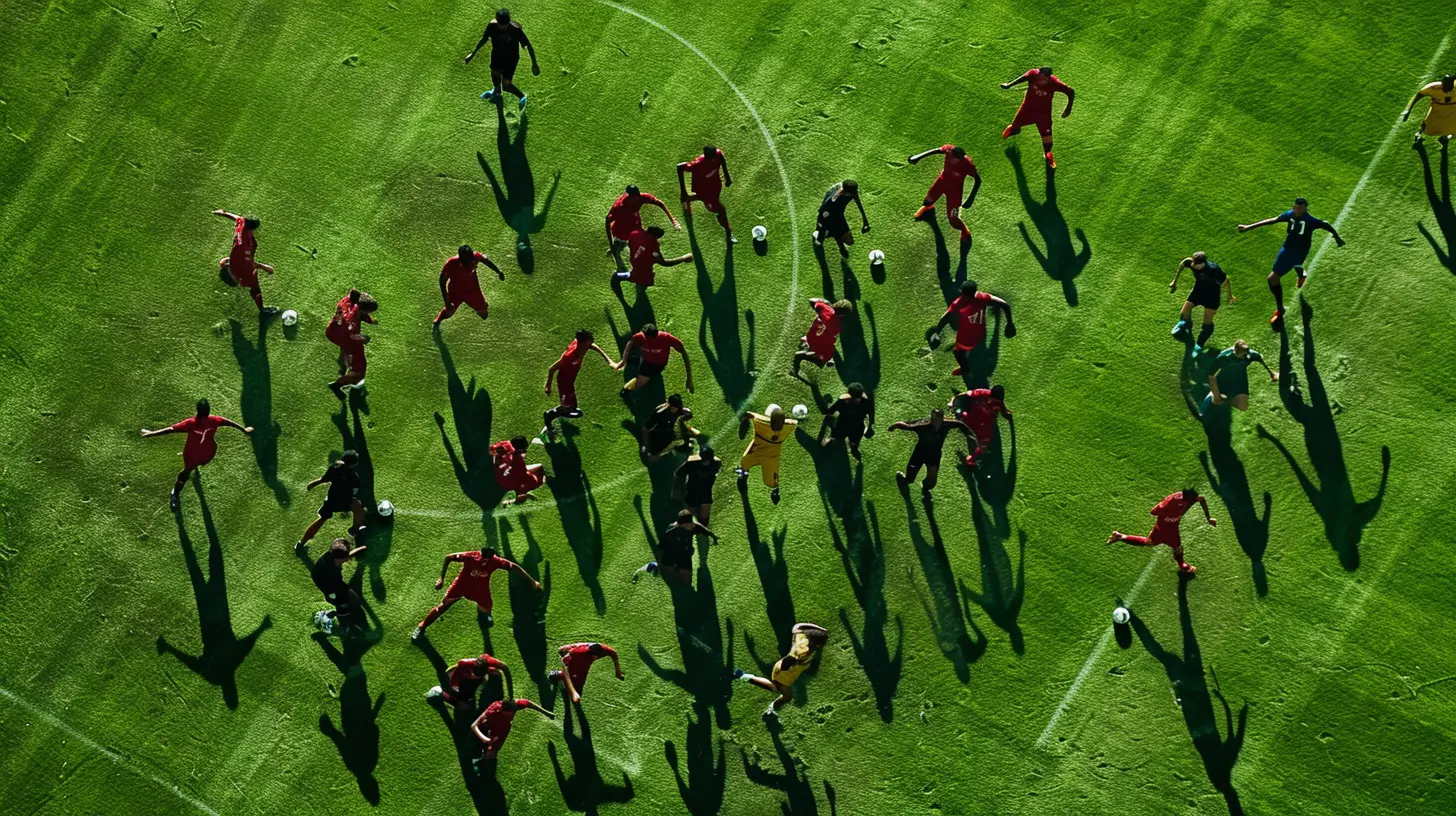The Power of the Overload in Soccer Tactics
15 August 2025
Soccer is a beautiful blend of strategy, athleticism, and timing. It’s not just about kicking a ball around – it’s a mental chess game played at full sprint. When we dive into modern tactics, one concept that keeps popping up in elite-level play is "the overload." But what does that actually mean? And why is it so darn effective?
Grab your notepad (or just stay comfy), because we’re about to break down one of the most powerful tactical weapons teams use to dominate the pitch.

What Is an Overload in Soccer?
Okay, picture this. You’re in a 5v5 pickup game, and suddenly three players from the other team shift to your side of the field. Now you’re dealing with a 3v1 down the wing. Overwhelming, right? That’s an overload in action.In simple terms, an overload happens when a team deliberately shifts more players to a specific area of the pitch — usually where the ball is — to outnumber the opposition. It’s all about creating a numerical advantage. You might see a 3v2 in midfield or a 4v3 near the opponent’s box. When used correctly, the overload causes confusion, creates space elsewhere, and opens up passing lanes.

Why Do Teams Use Overloads?
Think of it like this: In any sport, numbers matter. If you've got more players in a zone than the other team, you’ve got more options. More passing targets. More angles. More chances.Teams use overloads to:
- Break down stubborn defenses
- Control possession
- Pull defenders out of position
- Create space for key players
And guess what? It works at every level — from your local Sunday League to the Champions League Final.

The Science Behind It: Space and Time
Here’s where it gets juicy. Soccer isn’t played in a vacuum. It’s a dynamic, moving puzzle. When a team shifts players to one area and overloads it, the defending team is forced to react. They either:1. Shift their own players over — opening up space on the opposite side for a quick switch.
2. Stick to their positions — allowing the overloaded team to pass through with ease.
Either way, the attacking team benefits. It’s like a magician distracting you with one hand while pulling a rabbit out of the other. Deception meets execution.

Types of Overloads in Soccer
Not all overloads are the same. Different teams use different styles based on their philosophy and players. Let’s break down the main types:1. Positional Overload
These are the bread and butter of possession-based teams like Manchester City or Barcelona. The goal? Dominate a specific zone (usually midfield) by placing extra players there. Think triangles, short passes, and tight control.Ever watched Pep Guardiola’s teams? They often push an extra man into midfield — usually a fullback or center-back. This transforms a 2-man midfield into a 3 or 4-man unit, helping to suffocate opponents and dictate the tempo.
2. Wide Overload
This is all about the flanks. Teams push extra players to the wings — maybe a fullback, winger, and central midfielder — to outnumber the opponent’s wide defenders. Once they break through, they can whip in a cross or cut the ball back for a shot.This tactic is especially brutal when you’re facing a team that defends narrowly or plays with a back three. They simply can’t cover the width fast enough.
3. Rotational Overload
Now we’re getting fancy. A rotational overload adds a layer of movement and disguise. Instead of static positioning, players rotate into new zones. A winger tucks into midfield while a fullback bombs forward. A striker drops deep while a midfielder makes a run beyond.Why is this so effective? It causes confusion. Marking responsibilities blur. Defenders hesitate. And in that moment of hesitation, chances are created.
4. Central Overload
Some teams prefer to funnel everything through the middle. They flood central spaces with creative midfielders, looking to combine with quick passes and one-twos. It’s risky, but when you’ve got the right players? Devastating.Teams like Spain from their golden generation or modern-day Arsenal under Mikel Arteta love these tight central overloads. It’s all about technical mastery and quick decisions.
Real-Life Examples (That Will Make You Go “Ohhh!”)
Let’s look at some concrete examples that show just how lethal overloads can be.Manchester City and the Wide Overload
Pep’s teams are the kings of the flank overload. Watch how Joao Cancelo (originally a fullback) steps into midfield. This pulls defenders infield. Then, out wide, City have a 2v1 with a winger and midfielder. The pass gets played out wide, and just like that, they’re in behind.City does this so smoothly that most teams don’t even realize where it went wrong.
Liverpool’s Central Overload
Under Klopp, Liverpool often used their advanced midfielders and false-nine striker (think Firmino) to create pockets in central zones. Opposition midfielders can’t decide whether to track Firmino or hold their ground. Meanwhile, Salah or Mane makes a diagonal run into the chaos. Boom. Goal.Barcelona’s Positional Masterclass
During their tiki-taka era, Barcelona was surgical with positional overloads. Busquets, Xavi, and Iniesta controlled games by forming short triangles and constantly checking into space. Opponents were shuffled around like pawns.
How Do Defenders Stop an Overload?
Easier said than done, right? But there are a few ways defenders try to deal with overloads:- Shifting the block: Teams move their whole shape toward the ball side — compacting the space.
- Man-marking: Assigning players to mark danger men closely to shut down the numerical advantage.
- Zonal coverage: Letting players take responsibility for zones instead of individuals, so they aren’t pulled out of position.
Still, even the best defensive setups can crack under a well-executed overload.
Key Players in an Overload System
Let’s talk about roles. Not every player needs to be Iniesta to make overloads work, but certain players do shine in this system.1. Fullbacks
Modern fullbacks are superheroes. They’re expected to defend, attack, and often tuck inside like midfielders. They’re key to creating width or forming triangles on the wings.Think: Alphonso Davies, Achraf Hakimi, or Kyle Walker.
2. Creative Midfielders
These are your playmakers. They see the game two steps ahead and can exploit the tiniest gaps. You need them to ping the right passes and move into space.Think: Kevin De Bruyne, Luka Modrić, or Martin Ødegaard.
3. Wingers/Inside Forwards
These guys stretch the field and drag defenders wide or inward. They’re often the ones who benefit from the space created by the overload.Think: Mohamed Salah, Vinícius Jr, or Bukayo Saka.
4. The False Nine
This one’s optional, but deadly. A striker who drops deep pulls defenders out and helps create central overloads. It’s a move many traditional number nines aren’t comfortable with — but when it works, it’s chaos.Think: Lionel Messi in his Barcelona prime.
Overloads in Youth and Amateur Soccer
You might be thinking, “Great, but I’m not coaching Real Madrid.” Fair point. But overloads apply at all levels. Even in youth soccer, teaching players positional awareness and how to combine in numbers helps massively.Simple drills like 3v1 rondos or small-sided games force players to create and exploit overloads. It becomes second nature. The sooner young players start learning this tactic, the savvier they become on the pitch.
The Downsides: Yes, There Are Risks
Let’s keep it real — overloads aren’t foolproof. Here are the main risks:- Vulnerability to switches: If you overload one side and lose the ball, the opposite flank is wide open.
- Physical demands: Players have to cover a lot more ground, especially fullbacks.
- Overcomplication: If players aren’t in sync, the whole system breaks down.
It’s a high-reward tactic, but not without its price. That’s why timing, communication, and chemistry are key.
Wrapping It all Up: Why You Should Care
The beauty of overloads lies in their simplicity and complexity at the same time. It’s soccer’s version of “strength in numbers.” Whether you’re a casual fan, a coach, or a player, understanding the power of the overload gives you a deeper appreciation for the game’s tactical side.Next time you watch a match, keep an eye on how teams manipulate space, shift players, and try to outnumber the opposition in key zones. You’ll start noticing patterns. And once you see them, it’s hard to unsee them.
Because ultimately, soccer isn’t just about who has the better players — it’s about who uses them better.
all images in this post were generated using AI tools
Category:
TacticsAuthor:

Nelson Bryant
Discussion
rate this article
1 comments
Astraea McManus
The overload tactic transforms match dynamics, emphasizing creativity and spatial awareness, yet risks defensive vulnerabilities.
August 28, 2025 at 11:00 AM

Nelson Bryant
Thank you for your insightful comment! You’re spot on—while overload tactics can enhance creativity and spatial dynamics, the balance between offensive pressure and defensive solidity is crucial for success.

